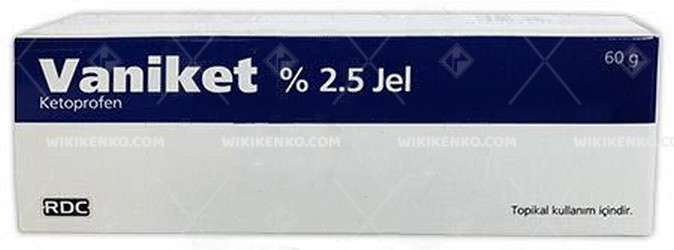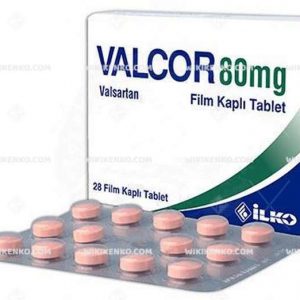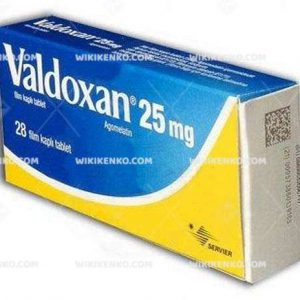Vaniket Gel
In the realm of topical medications, Vaniket Gel emerges as a notable solution, frequently encountered within Turkish pharmaceutical sources. This article delves into the depths of Vaniket Gel, offering a thorough exploration of its uses, potential side effects, and necessary precautions.
| Dosage form | |
|---|---|
| Pack size | |
| Potency | %2.5 60G |
| Manufacturer | |
| Origin | |
| Generic Name (Ingredient) | Each 1 Gram Of Gel Contains 25 Mg Of Ketoprofen. |
Assuming your emergency circumstances for this product, visit Urgent Quotation page. Besides, for any pharmaceutical questions, please ask us in the comments section.
Description
Uses and Indications
Vaniket Gel takes center stage primarily for its remarkable analgesic and anti-inflammatory properties. It becomes a therapeutic ally in the following conditions:
Osteoarthritis
A specific form of joint inflammation, stemming from tissue damage.
Periarthritis
An inflammatory response involving the soft tissues.
Tendinitis
A condition characterized by the inflammation of tendons, the vital connectors bridging muscles and bones.
Ingredients
| Characteristic | Details |
|---|---|
| Type of Medication | Topical Gel |
| Color and Transparency | Transparent and Colorless |
| Active Ingredient | Ketoprofen (25 mg per gram of the gel) |
Precautions and Contraindications
Before embarking on a journey with Vaniket Gel, consider these essential precautions:
- Abstain from the use of this gel if you bear the burden of heart, liver, or kidney insufficiencies.
- Exercise caution if applying the gel over substantial areas or planning an extended period of usage.
- After applying Vaniket Gel, shield the treated areas from sunlight or ultraviolet light to forestall the possibility of severe skin reactions. This protection should persist not only during treatment but for a subsequent two weeks.
- Hand hygiene stands as a vital ritual; make sure to thoroughly cleanse your hands after applying the gel.
- Should any unexpected skin reactions manifest post-application, discontinue use without delay.
- Remember, the last three months of pregnancy are not the appropriate period for employing Vaniket Gel.
Side Effects
In the realm of pharmaceuticals, side effects often make an unwelcome appearance, and Vaniket Gel is no exception. While not everyone may encounter them, awareness is key. Common and potential side effects include:
Common Side Effects
- Indigestion, stomach pain, and nausea, representing common gastrointestinal side effects.
- Changes in bowel habits, manifesting as diarrhea, constipation, or gas.
- Headaches, an inconvenience experienced by some.
- Sleep disruptions, where insomnia may cast its shadow.
- Feelings of nervousness or anxiety, occasionally making their presence felt.
- Swelling in the hands or feet, potentially signaling fluid retention.
Less Common Side Effects
Some users might find themselves grappling with skin reactions, encompassing burning, itching, redness, skin rash, swelling, or soreness at the application site.
This list is not exhaustive, and other side effects may occasionally emerge. Should any adverse effects surface during the use of Vaniket Gel, prompt cessation of use and consultation with a healthcare professional is prudent. The tailored guidance of a healthcare professional is paramount.
Benefits
Vaniket Gel, fortified with Ketoprofen as its active ingredient, unfolds a tapestry of advantages, primarily attributable to its analgesic and anti-inflammatory prowess.
Pain Relief
Vaniket Gel stands as a reliable ally in the quest for pain relief. It extends its healing touch to conditions like osteoarthritis, periarthritis, and tendinitis, offering respite from discomfort and distress.
Anti-Inflammatory Marvel
In the realm of inflammation, Vaniket Gel assumes the role of a quiet hero. It effectively reduces inflammation in the afflicted regions, thereby alleviating symptoms and fostering the process of recovery.
The Art of Localized Treatment
One of the standout features of Vaniket Gel is its ability to deliver localized treatment. This means that the medication targets precisely where it’s needed, sparing other organs from potential side effects and toxicity, a common concern with systemic medications.
The Elegance of Ease
Vaniket Gel adds a touch of simplicity to the healing process. Its ease of application and suitability for various body parts make it a versatile therapeutic companion.
While the benefits of Vaniket Gel are indeed commendable, they are best harnessed under the watchful eye of a healthcare professional. This ensures that the path to healing remains safe and effective.
Allergic Allure: Can Vaniket Gel Trigger a Reaction?
As with many topical medications, Vaniket Gel holds the potential to elicit allergic reactions in certain individuals. Recognizing the signs and taking appropriate action is crucial.
Symptoms of Allergic Reaction
Allergic reactions may manifest as rashes on various parts of the body, including the eyelids, face, neck, and genital region. In rare cases, even nails may loosen, and in exceptionally rare instances, breathing difficulties may ensue.
Prevention and Resolution
To prevent allergic reactions, a patch test should precede the use of Vaniket Gel or any novel topical medication. A small quantity of the gel should be applied to a patch of skin and observed for 24 hours to detect any untoward reactions.
In the event of an allergic reaction, immediate discontinuation of use is imperative, followed by consultation with a healthcare professional. They may recommend over-the-counter treatments or prescribe medication to manage the symptoms effectively.
Pregnancy Concerns
The active ingredient in Vaniket Gel, Ketoprofen, falls under the US FDA pregnancy category C. This classification signifies that while animal studies have unveiled adverse effects on fetuses, there remains a lack of adequate and well-controlled studies in humans. However, the potential benefits may outweigh the potential risks.
For individuals who are pregnant or contemplating pregnancy, it’s imperative to engage in a comprehensive discussion with a healthcare professional before considering the use of Vaniket Gel. Their counsel, rooted in your specific circumstances, can provide insights into the potential benefits versus the associated risks.
Breastfeeding Concerns
While specific information regarding the use of Vaniket Gel during breastfeeding may be scarce, it’s worth noting that most topical medications, including gels, exhibit minimal absorption into breastmilk. As a result, they can generally be used without disrupting the delicate dance of breastfeeding.
However, should the need arise to apply Vaniket Gel to the chest area, it should be done sparingly. Additionally, any visible product should be gently wiped off before breastfeeding to prevent inadvertent ingestion by the nursing infant.
In all circumstances, the wise course of action is to consult with a healthcare professional before incorporating any new medication into the breastfeeding routine. Their personalized guidance can assist in weighing the potential benefits against the possible risks, ensuring the well-being of both mother and child.
Conclusion
In conclusion, the journey with Vaniket Gel is one marked by its therapeutic potential and multifaceted considerations. The presence of a healthcare professional as a guide ensures that the path to healing remains not only therapeutic but also safe.
Use the form below to report an error
Please answer the questions as thoroughly and accurately as possible. Your answers will help us better understand what kind of mistakes happen, why and where they happen, and in the end the purpose is to build a better archive to guide researchers and professionals around the world.
The information on this page is not intended to be a substitute for professional medical advice, diagnosis, or treatment. always seek the advice for your physician or another qualified health provider with any questions you may have regarding a medical condition. Always remember to
- Ask your own doctor for medical advice.
- Names, brands, and dosage may differ between countries.
- When not feeling well, or experiencing side effects always contact your own doctor.
Cyberchondria
The truth is that when we’re sick, or worried about getting sick, the internet won’t help.
According to Wikipedia, cyberchondria is a mental disorder consisting in the desire to independently make a diagnosis based on the symptoms of diseases described on Internet sites.
Why you can't look for symptoms on the Internet
If diagnoses could be made simply from a textbook or an article on a website, we would all be doctors and treat ourselves. Nothing can replace the experience and knowledge of specially trained people. As in any field, in medicine there are unscrupulous specialists, differences of opinion, inaccurate diagnoses and incorrect test results.





Reviews
There are no reviews yet.